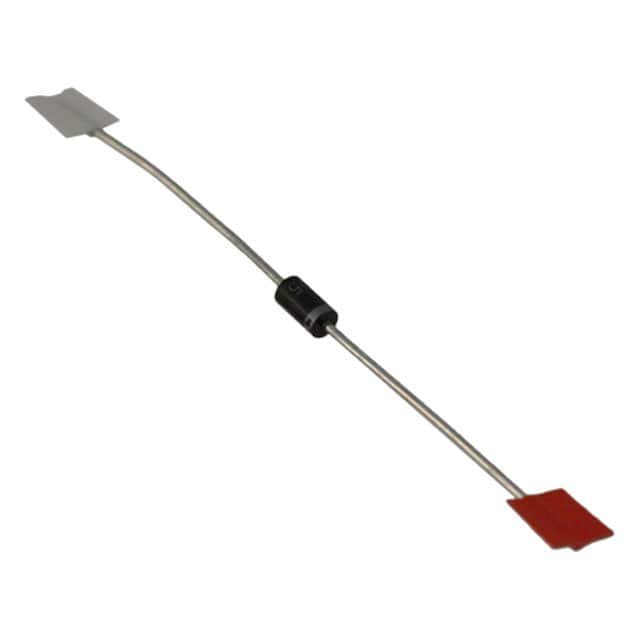1N5818-TP: Diode Encyclopedia Entry
Introduction
The 1N5818-TP is a diode that belongs to the category of Schottky diodes. This entry provides an overview of the basic information, specifications, pin configuration, functional features, advantages and disadvantages, working principles, application field plans, and alternative models of the 1N5818-TP diode.
Basic Information Overview
- Category: Schottky diode
- Use: Rectification, voltage clamping, and reverse polarity protection in various electronic circuits.
- Characteristics: Low forward voltage drop, fast switching speed, and low leakage current.
- Package: DO-41 (DO-204AL) package type.
- Essence: The 1N5818-TP is designed for high-efficiency rectification and voltage clamping applications.
- Packaging/Quantity: Available in tape and reel packaging with varying quantities.
Specifications
- Maximum Forward Voltage Drop: 0.45V at 1A
- Reverse Voltage: 30V
- Forward Current: 1A
- Operating Temperature Range: -65°C to 125°C
- Storage Temperature Range: -65°C to 150°C
Detailed Pin Configuration
The 1N5818-TP diode has two pins: 1. Anode (A) 2. Cathode (K)
Functional Features
- Fast switching speed
- Low forward voltage drop
- Low reverse leakage current
- High temperature operation capability
Advantages and Disadvantages
Advantages
- Low forward voltage drop reduces power dissipation.
- Fast switching speed allows for efficient rectification.
- Suitable for high-frequency applications.
- Compact DO-41 package for easy integration into circuits.
Disadvantages
- Limited reverse voltage rating compared to other diode types.
- Higher cost compared to standard silicon diodes.
Working Principles
The 1N5818-TP operates based on the Schottky barrier principle, where the metal-semiconductor junction provides fast switching and low forward voltage characteristics. When forward biased, it allows current flow with minimal voltage drop, making it suitable for high-efficiency rectification.
Detailed Application Field Plans
The 1N5818-TP diode finds extensive use in the following applications: - Switching power supplies - DC-DC converters - Reverse polarity protection circuits - Voltage clamping circuits - Solar panel bypass diodes
Detailed and Complete Alternative Models
Some alternative models to the 1N5818-TP diode include: - 1N5817-TP: Lower reverse voltage rating - 1N5819-TP: Higher reverse voltage rating - SS14: Standard recovery rectifier diode - BAT54S: Dual Schottky diode
In conclusion, the 1N5818-TP diode offers fast switching speed, low forward voltage drop, and high efficiency, making it suitable for various rectification and voltage clamping applications in electronic circuits.
[Word count: 411]
Please let me know if you need any further information or modifications!
Lista 10 Vanliga frågor och svar relaterade till tillämpningen av 1N5818-TP i tekniska lösningar
What is the 1N5818-TP diode used for?
- The 1N5818-TP diode is commonly used in rectification and voltage regulation applications due to its low forward voltage drop and high current capability.
What are the key specifications of the 1N5818-TP diode?
- The 1N5818-TP diode has a maximum average forward current of 1A, a maximum reverse voltage of 30V, and a low forward voltage drop of typically 0.45V at 1A.
Can the 1N5818-TP diode be used in high-frequency applications?
- Yes, the 1N5818-TP diode is suitable for high-frequency applications due to its fast switching speed and low junction capacitance.
How does the 1N5818-TP diode compare to other diodes in terms of efficiency?
- The 1N5818-TP diode offers high efficiency in rectification circuits due to its low forward voltage drop, which minimizes power loss.
What are some typical applications of the 1N5818-TP diode?
- The 1N5818-TP diode is commonly used in DC-DC converters, voltage clamping circuits, reverse polarity protection, and low voltage rectification.
Is the 1N5818-TP diode suitable for automotive applications?
- Yes, the 1N5818-TP diode is often used in automotive electronics for tasks such as voltage regulation and protection against reverse voltage.
What precautions should be taken when using the 1N5818-TP diode in a circuit?
- It's important to ensure that the maximum forward current and reverse voltage ratings are not exceeded, and proper heat sinking may be required for high-power applications.
Can the 1N5818-TP diode be used in parallel to increase current handling capacity?
- Yes, the 1N5818-TP diode can be used in parallel to share the current load, but it's essential to ensure that each diode shares the current equally.
Does the 1N5818-TP diode have any temperature limitations?
- The 1N5818-TP diode has an operating temperature range of -65°C to +125°C, making it suitable for a wide range of environments.
Are there any potential alternatives to the 1N5818-TP diode for similar applications?
- Yes, alternatives such as the 1N5817-TP, 1N5819-TP, or Schottky diodes from other manufacturers can be considered based on specific application requirements.


